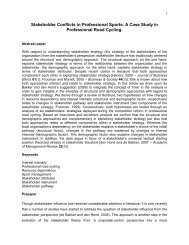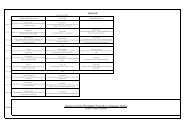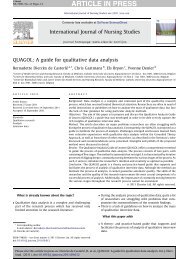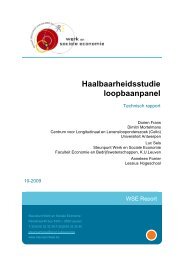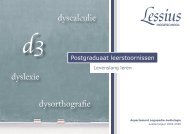The role of implicit attitudes towards food and ... - ResearchGate
The role of implicit attitudes towards food and ... - ResearchGate
The role of implicit attitudes towards food and ... - ResearchGate
You also want an ePaper? Increase the reach of your titles
YUMPU automatically turns print PDFs into web optimized ePapers that Google loves.
during the therapy because <strong>of</strong> having reached their therapy goal (n =4) or because <strong>of</strong> suspension due to behavioural<br />
problems breaking the rules <strong>of</strong> the centre such as smoking (n=10). Five could not be contacted at follow up. <strong>The</strong>se<br />
youngsters did not differ from the rest <strong>of</strong> the group in terms <strong>of</strong> gender, χ 2 b1, <strong>and</strong> baseline overweight, tb1. Both<br />
groups differed in age, t(36) =2.12, p b.05: <strong>The</strong> mean age <strong>of</strong> the dropout group was higher (M=14.53, SD=2.37) than<br />
the mean age <strong>of</strong> the study group. Data were analyzed on this restricted group <strong>of</strong> nineteen youngsters, representing 50%<br />
<strong>of</strong> the original sample that was tested in Craeynest et al. (2005). According to Cole, Bellizzi, Flegal, <strong>and</strong> Dietz (2000),<br />
all <strong>of</strong> them could be categorized as severely obese (mean ABMI 1 = 163.86, SD=14.97; 7 boys; age M=12.79,<br />
SD=2.68; range 9–18 yo).<br />
2.2. Treatment program<br />
<strong>The</strong> treatment consisted <strong>of</strong> a maximum twelve-month multi-component inpatient program. <strong>The</strong> duration <strong>of</strong> the<br />
treatment depended on the individual therapy goal <strong>of</strong> each participant. Every week <strong>and</strong> half <strong>of</strong> the school holidays, the<br />
youngsters returned home. <strong>The</strong> program focused on attaining a healthy lifestyle by increasing physical activity <strong>and</strong> <strong>of</strong>fering<br />
a healthy diet within a cognitive behavioural framework. For an extensive description <strong>of</strong> the program, we refer to Braet et<br />
al. (2003). In short, concerning physical activity, all children received an individual physical training program for 4 h a<br />
week, including swimming, biking <strong>and</strong> fitness. Before <strong>and</strong> after school they were stimulated to participate for at least 2 h a<br />
day in active games <strong>and</strong> lifestyle activities. During the weekends <strong>and</strong> the holidays they spent at home, they noted how<br />
much they were physical active, using a diary. Provided that a stringent calorie restriction is not recommended for<br />
youngsters that are still growing, the diet contained between 1500 <strong>and</strong> 1800 kcal/day. More specifically, it consisted <strong>of</strong><br />
three meals <strong>and</strong> three snacks per day. <strong>The</strong> consumption <strong>of</strong> s<strong>of</strong>t drinks, sweets <strong>and</strong> high-calorie <strong>food</strong> was strictly regulated,<br />
but not completely banned. Further, the psychological counselling consisted <strong>of</strong> a twelve-week cognitive behavioural<br />
treatment program in small groups, followed by weekly individual problem-solving-based booster sessions. In order to<br />
change their lifestyle, the youngsters were taught self-modulating skills, such as self-regulation (e.g., self-observation <strong>and</strong><br />
self-instruction), self-evaluation, <strong>and</strong> self-reward. Finally, the program also involved the parents. <strong>The</strong>ywereprovided<br />
information in how the lifestyle <strong>of</strong> their child could change within the family.<br />
2.3. Materials<br />
2.3.1. Extrinsic Affective Simon Task<br />
Participants conducted two EASTs: One task was related to physical activity, <strong>and</strong> one related to <strong>food</strong>. An EAST<br />
assessing <strong>attitudes</strong> consists <strong>of</strong> attribute stimuli (words carrying a clear valence) <strong>and</strong> target stimuli (stimuli <strong>of</strong> which the<br />
<strong>attitudes</strong> are assessed). Individually selected attractive <strong>food</strong> <strong>and</strong> physical activity words were used for the attribute<br />
stimuli. In the physical activity EAST, targets were nine pre-selected words related to physical activity, divided into<br />
three categories: sedentary activities (e.g., watching television), moderate intense activities (e.g., swimming) <strong>and</strong> high<br />
intense activities (e.g., exercising). In the <strong>food</strong> EAST, targets were pre-selected words related to <strong>food</strong>, divided into two<br />
categories: unhealthy <strong>food</strong> (e.g., French fries) <strong>and</strong> healthy <strong>food</strong> (e.g., apple). All target stimuli words are presented in<br />
the Appendix. For a more extended description <strong>of</strong> the EASTs, we refer to Craeynest et al. (2005).<br />
2.3.2. Self-reports<br />
Participants had to rate the valence <strong>of</strong> the <strong>food</strong> <strong>and</strong> physical activity target stimuli words <strong>of</strong> the EASTs on a 7-point<br />
rating scale, ranging from ‘dislike’ (−3) to ‘like’ (+3).<br />
2.4. Procedure<br />
M. Craeynest et al. / Eating Behaviors 9 (2008) 41–51<br />
This study was approved by the Ethical committee <strong>of</strong> Ghent University. To investigate their change over the<br />
treatment period, participants were tested three times: at baseline (during the first three weeks <strong>of</strong> the treatment; T1),<br />
1 <strong>The</strong> Body Mass Index (BMI; weight/height 2 ; kg/m 2 ) is accepted as a reliable <strong>and</strong> valid index <strong>of</strong> relative adiposity. However, as mean normal<br />
values <strong>of</strong> BMI vary substantially with age <strong>and</strong> values for individuals <strong>of</strong> different ages are difficult to compare, an adjusted BMI (ABMI) was used.<br />
ABMI was calculated using the formula (actual BMI/ideal BMI [50th percentile for same sex <strong>and</strong> age])×100 (Valverde, Patin, Oliveira, Lopez, &<br />
Vitolo, 1998). <strong>The</strong> 50th percentiles were derived from Flemish growth reference charts. An ABMI <strong>of</strong> 100% is considered ideal.<br />
43




